a policy report from ICPH
November 2015
School absences are pervasive across New York City. Almost 1 in 5 New York City public school elementary students (19%) were chronically absent in SY 2013–14, missing 20 days or more of school. Worse, homeless elementary students were chronically absent at roughly twice the rate of elementary students overall. Chronic absenteeism is correlated with lower test scores, an increased risk of being held back, and higher dropout rates. Homeless students disproportionately face these challenges, and their greater likelihood of being chronically absent places them at even more risk. This report builds on the work of the 2015 Atlas of Student Homelessness in New York City by examining the disparities in absenteeism and its impact on educational achievement, comparing homeless students and their housed peers, regardless of family income level.
Key Findings
Homeless elementary students missed an average of four weeks of school (19 days) in SY 2013–14. This was a week and a half more than low-income housed students (12 days) and two weeks more than non-low-income housed students (9 days).
Homeless children were chronically absent at almost twice the overall citywide rate—36% compared to 19% in SY 2013–14.
Among homeless elementary students, those living in shelter had the highest rate of chronic absenteeism. In SY 2013–14, 58% of students living in shelter were chronically absent compared to 25% of homeless students who were living doubled up.
Homeless children enroll in schools where high rates of chronic absenteeism are already a problem. More than 10,000, or 28% of homeless elementary students were enrolled in schools where over 1/3 of all students were chronically absent in SY 2013–14.
School transfers greatly increase rates of chronic absenteeism. Of the 1,600 homeless elementary students living in shelter who transferred twice or more in SY 2013–14, 80% were chronically absent.
Chronically absent homeless children repeated the same grade at over three times the rate of homeless students who missed fewer than five school days in SY 2013–14.
Homeless elementary students who missed fewer than five days of school passed State assessment tests at about the same rate as their low-income housed peers (38% compared to 37%). Just 12% of chronically absent homeless students achieved proficiency in either their English Language Arts or Math test.
The Absenteeism Epidemic
While high absenteeism rates are an overall problem for the New York City Department of Education, chronic absenteeism is particularly startling among homeless elementary students. Of the over 43,000 homeless children in grades K–5, almost 16,000 were chronically absent in SY 2013–14, or more than one-third of all young homeless students. Among public elementary schools citywide, chronic absenteeism ranged between 2% and 78% for homeless students. While the largest disparity in chronic absenteeism (36% compared to 9%) was between homeless students and housed students who were not receiving free or reduced-price lunch— a proxy for low-income status1—the problem goes beyond poverty. As seen in Figure 1, young homeless students were also chronically absent at a rate almost twice as high as their housed peers who were low-income (36% compared to 20%).
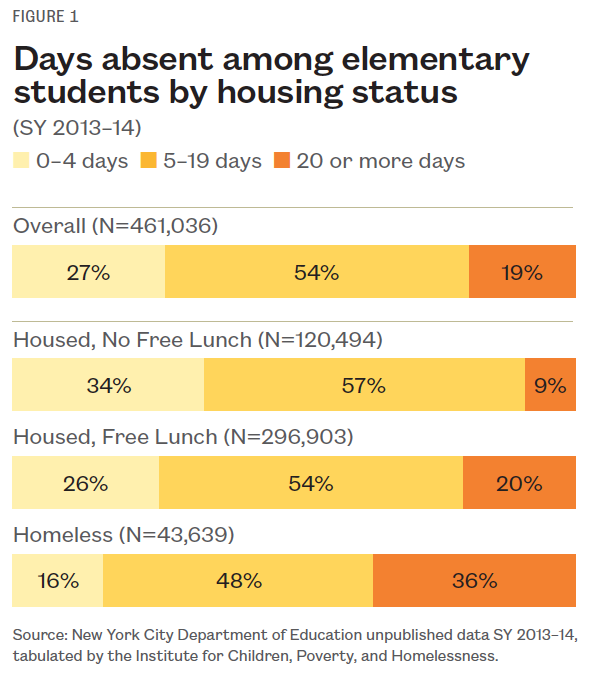
Students Living in Shelters Confront the Highest Risk
Although homeless students were more likely to be chronically absent than those who were housed, rates varied depending on the type of temporary housing. For instance, students living in homeless shelters faced a far greater risk of being chronically absent than those living doubled up.* As seen in Figure 2, citywide, over half of sheltered elementary students (58%) were chronically absent in SY 2013–14 compared to 25% of doubled-up students. At some schools, such as P.S. 41 in District 11 in the Williamsbridge area of the Bronx, homeless students had even higher rates of absenteeism, with as many as 84% of elementary students living in shelters and 63% of doubled-up students chronically absent.
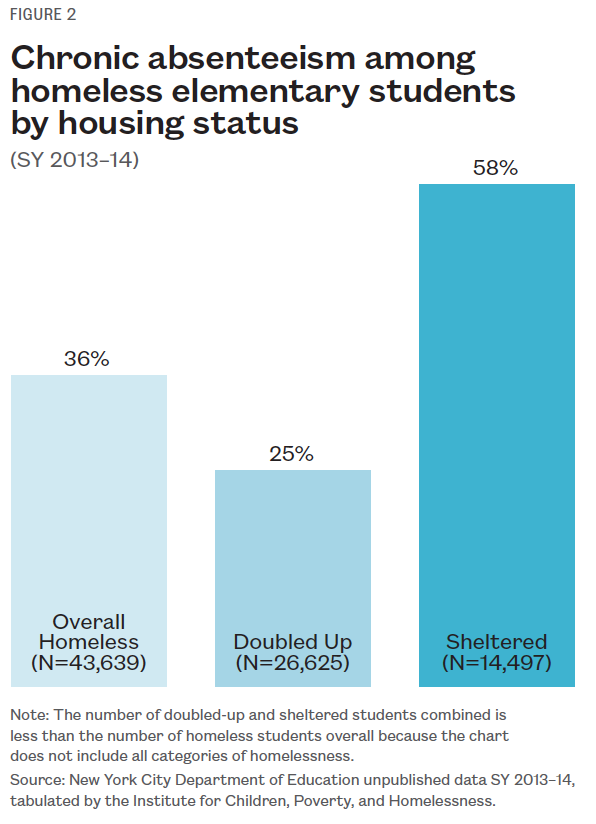
Impact of School Transfers on Homeless Students’ Absenteeism Rate
School transfers were much more frequent among homeless students. As shown in Figure 3, doubled-up students transferred at twice the rate of elementary students overall and sheltered students transferred at over three times the rate. Transfers negatively impacted attendance for all students, but were particularly damaging to homeless children’s ability to maintain consistent attendance. Among elementary students who transferred two or more times in SY 2013–14, Figure 4 shows that sheltered students saw the highest rate of chronic absence (80%) followed by doubled-up students (57%). These were compared to housed students receiving free or reduced-price lunch at 48% and housed students not eligible for free or reduced-price lunch at 34%. While sheltered students had the highest rate of chronic absenteeism, all students saw an increase in chronic absence for every additional transfer. Doubled-up students, however, saw the greatest percentage-point increase with a 34 percentage-point gap between those with no transfers and those with two or more transfers (23% compared to 57%) (Figure 4).
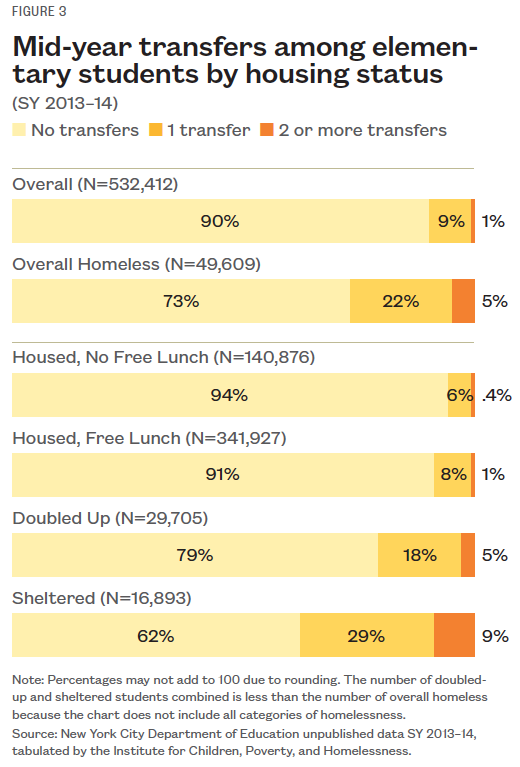
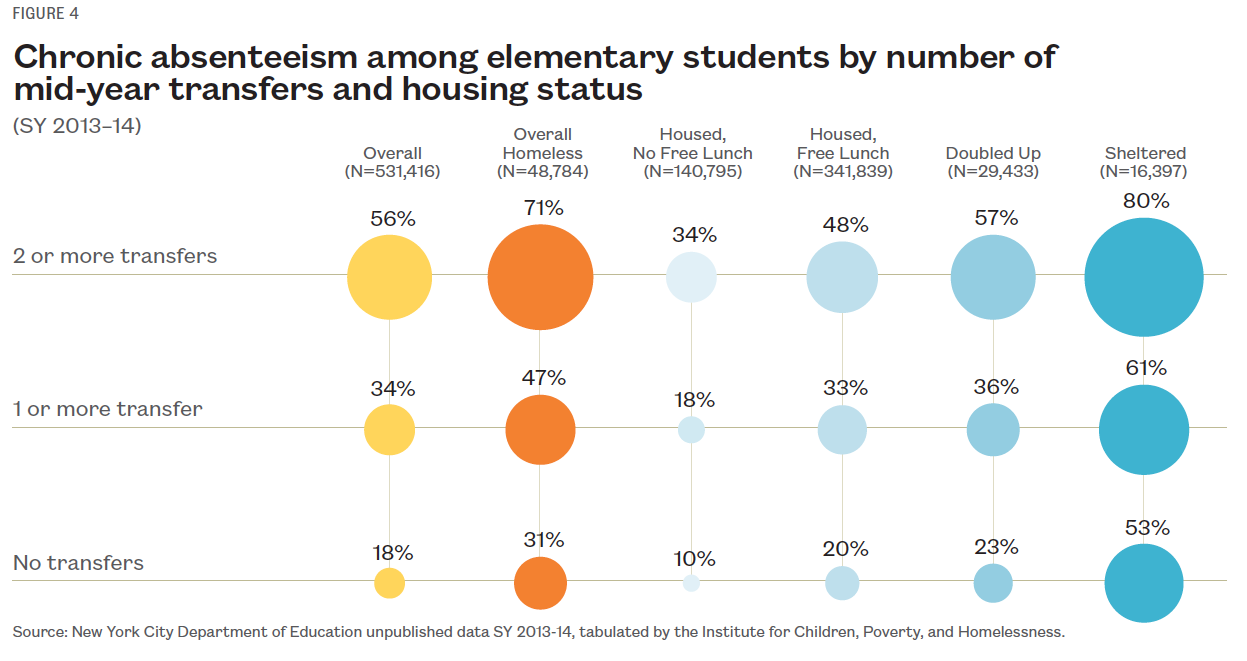
xxx
School-Wide Absenteeism
Absenteeism is a problem that disproportionately affects homeless elementary students, but also some schools as well. Homeless students were far more likely to attend elementary schools with higher overall chronic absenteeism even when the absences of homeless students were not included in school-wide absenteeism level calculations. As seen in Figure 5, in high-absenteeism elementary schools—schools with one-third or more of all students chronically absent—20% of students were homeless, on average. In low absenteeism schools—schools with one-tenth or fewer of all students chronically absent—just 4% of students were homeless. In SY 2013–14, one-quarter of all homeless elementary school students (over 10,000 children) attended elementary schools where 33% or more of students were chronically absent. High school-wide absenteeism has been shown to undermine academic outcomes for all students, even those with perfect attendance records.2 Figure 6 shows that these high-absenteeism schools are concentrated in areas of the south Bronx, upper Manhattan, and central Brooklyn, areas that are already known to struggle with high rates of neighborhood poverty.
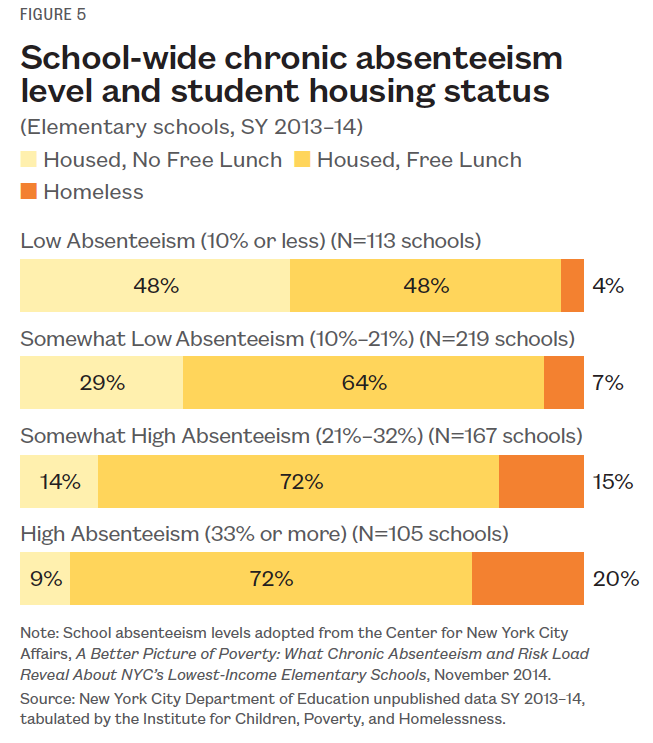
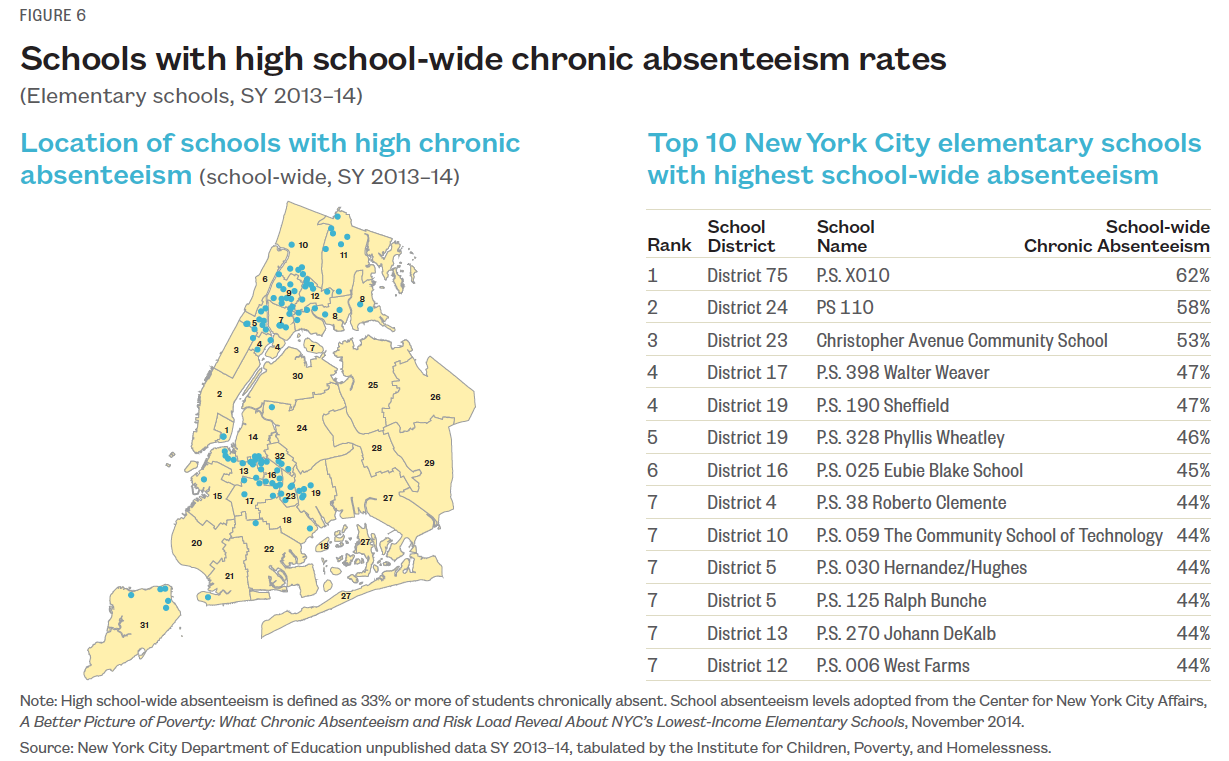
xxx
The Educational Impact of Chronic Absenteeism
When homeless children miss a large number of school days, their chances of succeeding in school decline. As shown in Figure 7, in SY 2013–14, chronically absent homeless students passed one or both 3rd–8th grade State assessment tests only one-third as often as students who missed fewer than 5 days. While 1 in 8 (12%) chronically absent homeless students passed at least one exam in SY 2013–14, homeless students who missed 4 or fewer school days passed at about the same rate as low-income housed students (38% compared to 37%) (Figure 7).
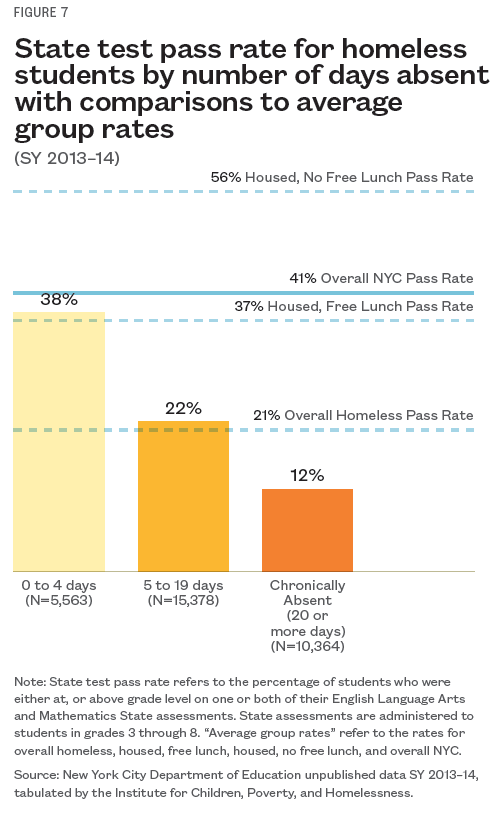
Absenteeism was also associated with an increased risk for being held back a grade. One in 10 homeless elementary students (10.5%) who were chronically absent were held back the following year, compared to much lower rates for those who were not chronically absent (Figure 8). Homeless elementary students who were chronically absent in SY 2012–13 were over twice as likely to be held back the following year.
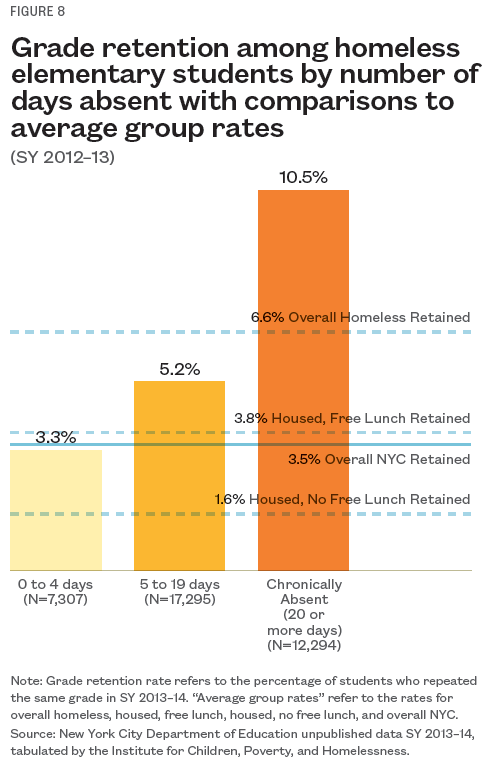
Fighting Absenteeism Among New York City’s Most Vulnerable Children
Young homeless students who are chronically absent face a tremendous risk of failing their 3rd–8th grade State tests and being held back. Meanwhile, those who attend school consistently see educational outcomes similar to housed students. This highlights the vital importance of helping homeless elementary students get to school—a task that will require engagement not just on the school’s part, but also from the larger community. Programs to reduce absenteeism that have seen the greatest success have tackled the problem on multiple levels, adding in activities before and after school to increase students’ desire to attend, following up with parents immediately when a student is not at school to identify the reason for the absence, and helping families to address health issues and other barriers that lead to absences. Key to success will be identifying the specific attendance support needs of homeless students. Additionally, more needs to be learned about why students who are living in family shelters have such high rates of chronic absenteeism overall, and the potential supports that could be added when a family applies for shelter at the Prevention Assistance and Temporary Housing center (PATH), the main point of entry into the shelter system.
Education policymakers have long known that high absences are associated with lower assessment scores, increased grade retention and reduced graduation rates—consequences for which homeless students are already at risk. With almost 16,000 homeless elementary students chronically absent citywide in SY 2013–14, addressing the relationship between homelessness and absenteeism and engaging shelters so that they can be a resource to homeless children struggling with school attendance could mean a better educational future for many of New York’s most vulnerable children.